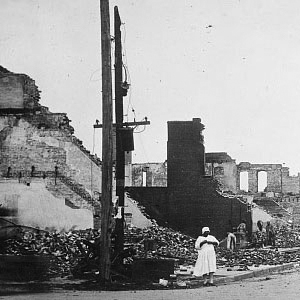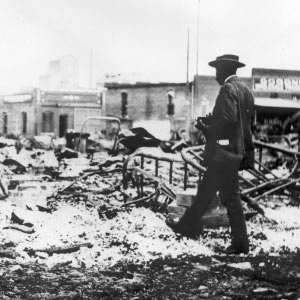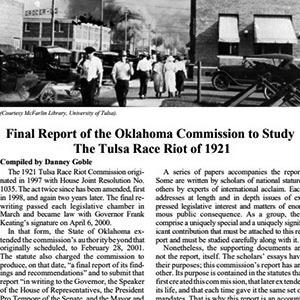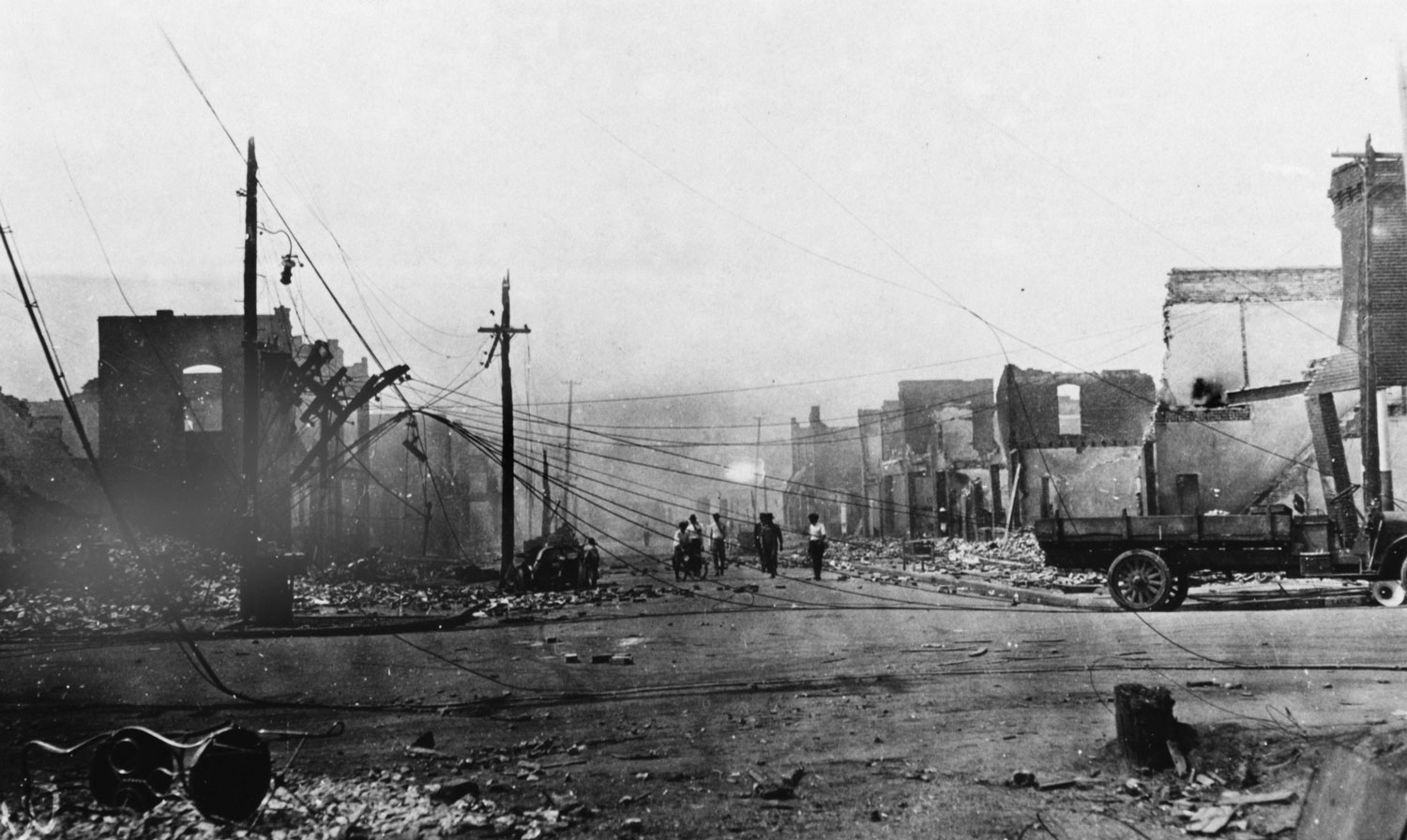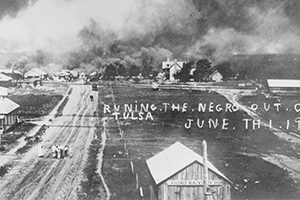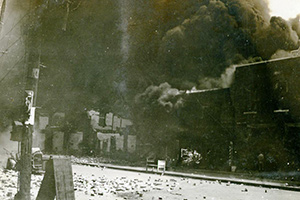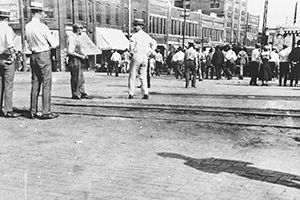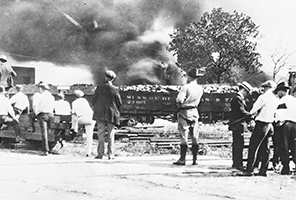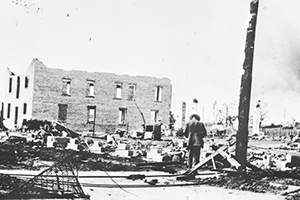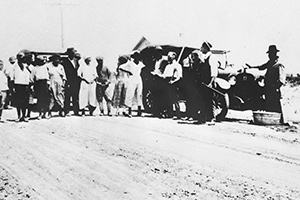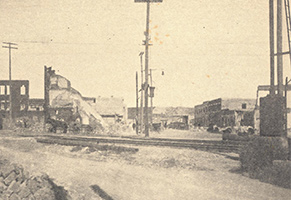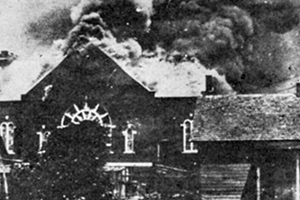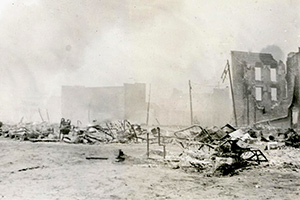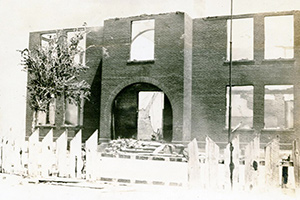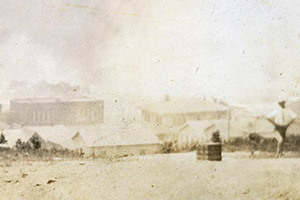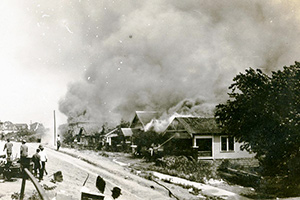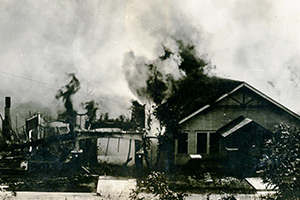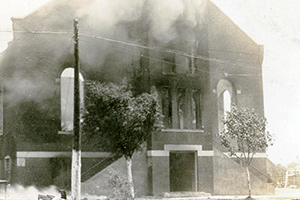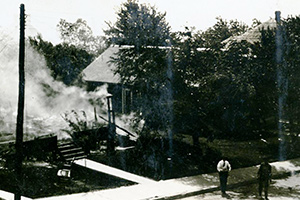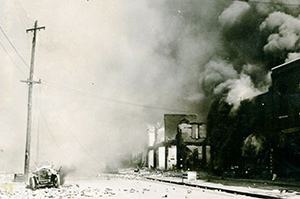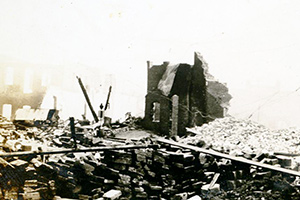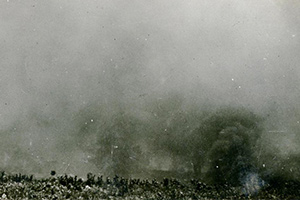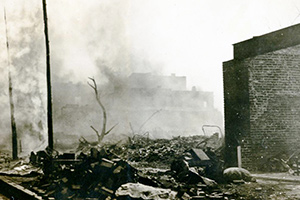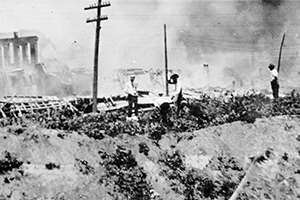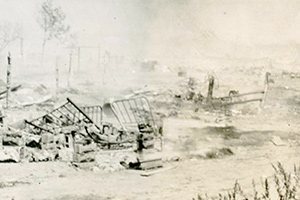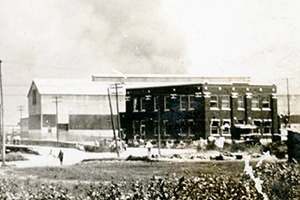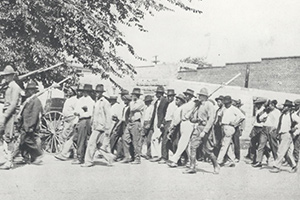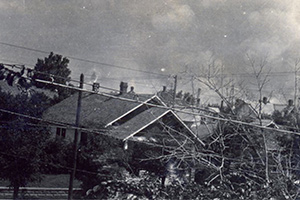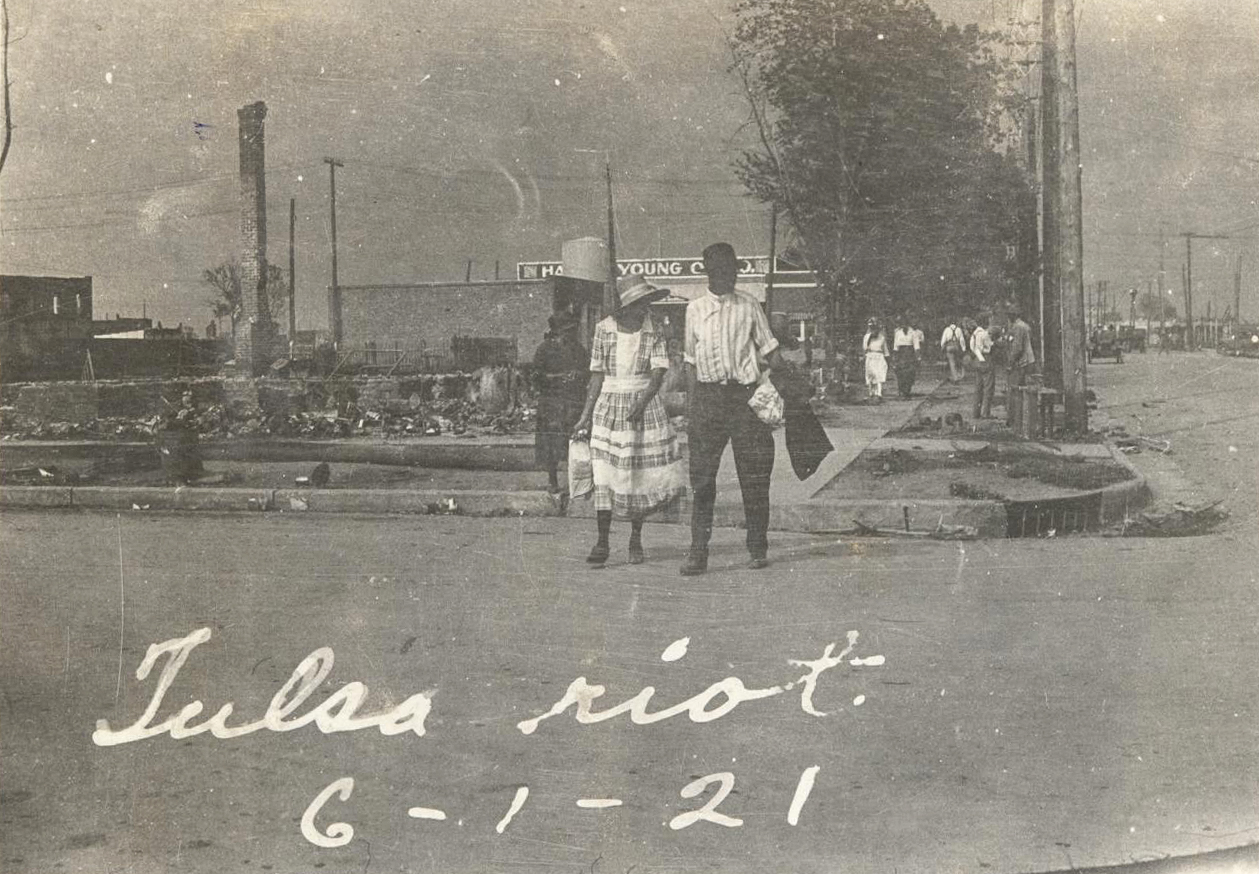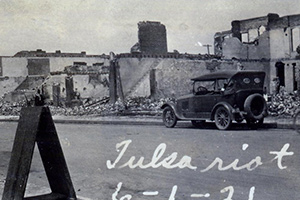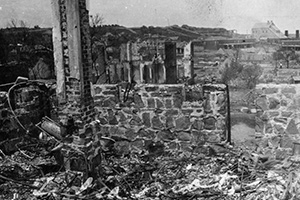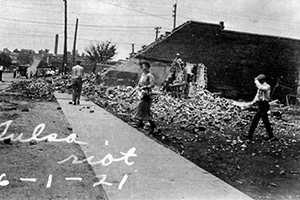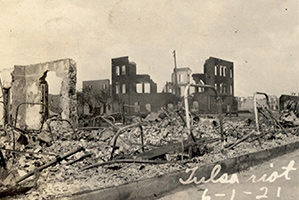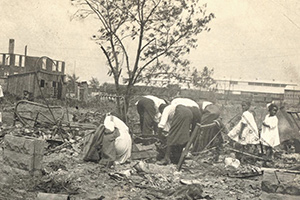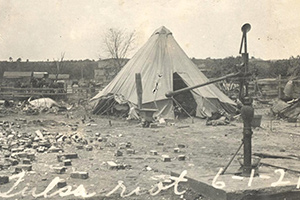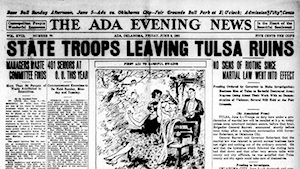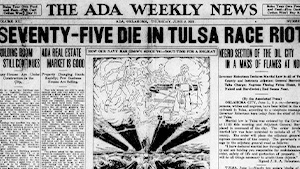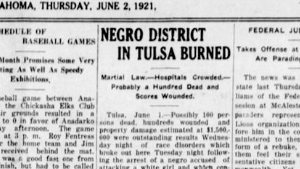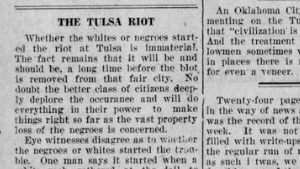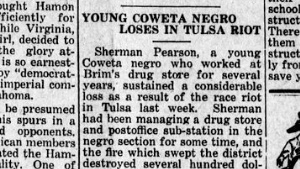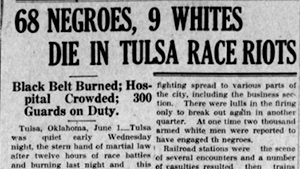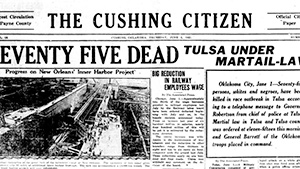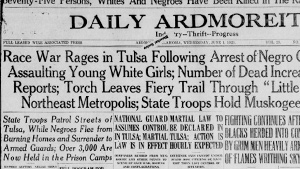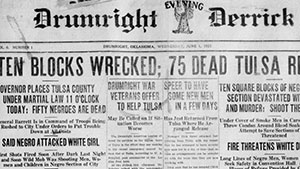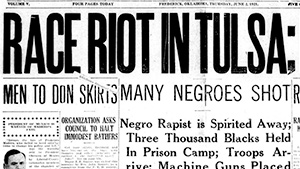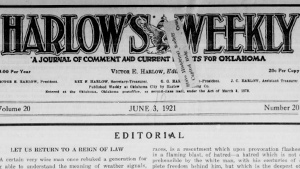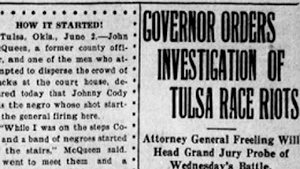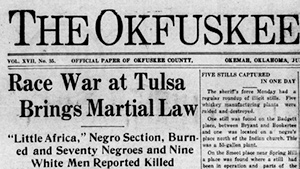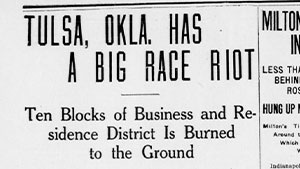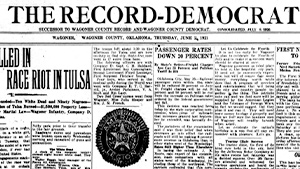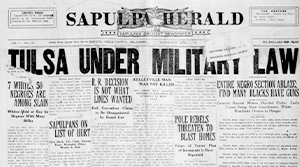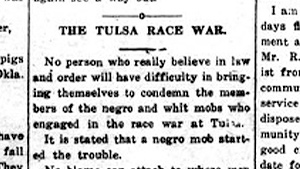
The 1921 Tulsa Race Massacre
This page includes Oklahoma Historical Society resources and collections that chronicle the 1921 Tulsa Race Massacre, a devastating event in our state’s history.
These materials include historical accounts, text, and photographs, which may include offensive language, negative stereotypes, and descriptions of traumatic events. Materials are presented uncensored and unaltered to reflect the historical record, and some content may be disturbing to viewers. These do not necessarily represent the viewpoints of the Oklahoma Historical Society.
Resources for Educators
Lesson Plans
Black Wall Street
The Tulsa Race Massacre
Riot Versus Massacre
Teacher Resource Guides
correlating to Oklahoma History Academic Standards
OKH.5.2, Examine multiple points of view regarding the evolution of race relations in Oklahoma
Photographs
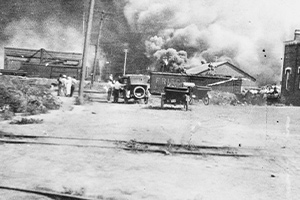
The sky is filled with billowing smoke during the fires (16939, Oklahoma Historical Society Photograph Collection)
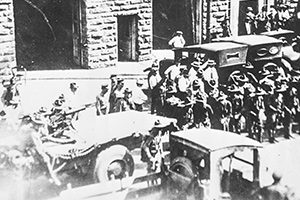
Troops with rifles in front of the police station (16937, Oklahoma Historical Society Photograph Collection)
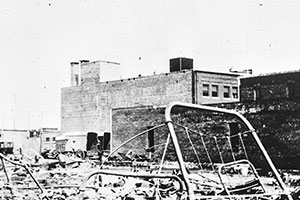
Bed frames rising from the ashes of a burned out building (16945, Oklahoma Historical Society Photograph Collection)
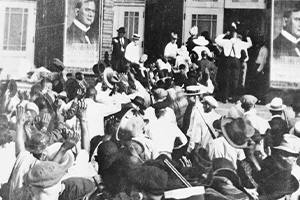
African Americans with arms raised surrounded by armed whites (16946, Oklahoma Historical Society Photograph Collection)
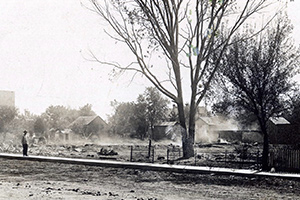
Smoldering ruins at an edge of the fired area during the massacre (19687.BL.RR.1.1, Chester R. Cowen Collection)
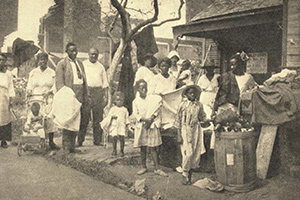
Reverend R. A. Whitaker and his family distributing relief goods (21516.31, Mary E. Jones Parrish Collection)
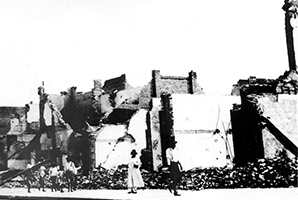
Rubble and brick walls after the fires subsided (15583.A, Oklahoma Historical Society Photograph Collection)
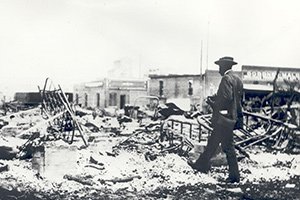
An African American man with a camera looking at the skeletons of iron beds (5583.B, Oklahoma Historical Society Photograph Collection)
Audio and Video
A Very OK Podcast
“The 1921 Tulsa Race Massacre”
“Black Wall (Main) Street”
“Legacy of the Tulsa Race Massacre” Roundtable Discussion (2021)
“Legacy of the Tulsa Race Massacre” was a roundtable discussion focused on how race relations developed in Oklahoma after one of the state’s most horrific events, the Tulsa Race Massacre. The panel presented perspectives representing different aspects of the state’s African American community. Moderated by J. D. Baker, special assistant to Oklahoma City Mayor Holt, the panel included Brenda Alford, who shared her family’s story of surviving the Tulsa Race Massacre; Oklahoma State University professor Dr. Brandy Thomas Wells, who provided historic context for and ramifications of the massacre; and Reverend Dr. Robert Turner of Historic Vernon Chapel A. M. E. Church, who shared the perspective of a community leader in Tulsa.
“A Conversation with Hannibal B. Johnson: The Tulsa Race
Massacre and Greenwood Rising”
Hannibal B. Johnson, esquire, is chair of the Education Committee for the 1921 Tulsa Race Massacre Centennial Commission and local curator of Greenwood Rising. Larry O’Dell is the director of development and special projects for the Oklahoma Historical Society. Part of the 2021 Oklahoma History Conference, this presentation gives an overview of the Greenwood District, the Tulsa Race Massacre, the district’s recovery, and the marking of the massacre’s 100th anniversary.
Through the Looking Glass Darkly, Part III (1973) (F2013.134.2.0026, WKY-TV Moving Image Collection)
From WKY-TV News, this documentary shares stories of Black Oklahomans from pre-statehood to the 1970s through rare photographs and interviews.
Oklahoma Historical Society Oral History Collection Interviews
This list includes interviews from the 1980s with survivors or individuals who recall the Tulsa Race Massacre. Use the links below to listen on YouTube.
Ethelyn Gimlin (H1983.109)
Thomas and Mary Hamilton (H1984.019)
Ruth Powers (H1983.101)
Zola Faye Sells (H1982.052)
Earkysee Sutton (H1982.029)
Mary Magdaline Wyatt (H1982.061)
Tulsa Race Riot (Massacre) Commission Interviews
These interviews were conducted in the 1990s. Use the links to view the interviews on YouTube.
Tape 1 (1999.069.01) - introduction by Eddie Faye Gates, and interviews with George Monroe, Lola Streeter-Jackson, Veneice Dunn-Simms, Kenny Booker, Edward Lett, and Ernestine Gibbs
Tape (1999.069.02) - interviews with Ernestine Gibbs, Ruby McCormick, Wes Young, Otis Clark, and Joe Burns
Tape 3 (1999.069.03) - interviews with Elizabeth Cooley Chappelle, Annie Birdie Beard, Augusta Mann, George Monroe, and Eldoris McCondichie
Tape 4 (1999.069.04) - interviews with Jobie Elizabeth Holderness, Eunice Jackson, Myrtle Rollerson, and Beulah Loree Smith

Vernon A.M.E. Church
Most of the historic resources directly associated with Greenwood were destroyed during the massacre and many of the resources from the period of post-massacre reconstruction were destroyed by urban renewal in the 1970s. Vernon A.M.E remains a testimony to the resilience of the Greenwood neighborhood, and is significant for its role in understanding race relations in the US under legal segregation; in community planning and development for its representation of the initiation and growth of a segregated community within the city of Tulsa as well as reconstruction after the 1921 massacre; and in social history for its depiction of racial intolerance against African Americans. Learn More
Archival Materials
2006.018. Tulsa Race Riot Commission Collection, 1921–1923 / 1997–2001
View the Tulsa Race Riot Commission Collection finding aid
The Tulsa Race Riot Commission was created by the Oklahoma Legislature in 1997 under HB 2468. The mission of this organization was to study and provide a report of the Tulsa Race Riot of 1921 that would also help to give reparations for the tragic losses of those from the Greenwood District. The committee accomplished this by using a variety of sources that took roughly three and a half years to compile. This collection contains newspaper articles, interviews from survivors, death certificates, court cases filed against insurance companies, along with many photographs and statistics documenting the devastation that occurred during the eighteen-hour riot between May 31 and June 1, 1921. The final report was submitted on February 21, 2001.
These PDFs contain thousands of pages from the Tulsa Race Riot Commission Collection.
OHS-201 - Commission Information and Research. 1,090 pages.
OHS-202 - Documentation, Database, and Correspondence. 1,142 pages.
OHS-203 - Analysis and Final Report. 726 pages.
OHS-204 - Case Dockets #16013-19166, 1921. 1,070 pages.
OHS-205 - Case Dockets #19167-19221, 1921. 1,186 pages.
OHS-206 - Case Dockets #19221-19275, 1921. 1,201 pages.
OHS-207 - Case Dockets #23279-23346, 1921. 1,229 pages.
OHS-215 - Case Dockets #23347-23416, 1921. 1,061 pages.
Newspapers
Early Oklahoma newspapers reported the Tulsa Race Massacre and its aftermath; below are just a few examples of those publications, which reflect the segregated media of the period. Search and view more newspapers on The Gateway to Oklahoma History.
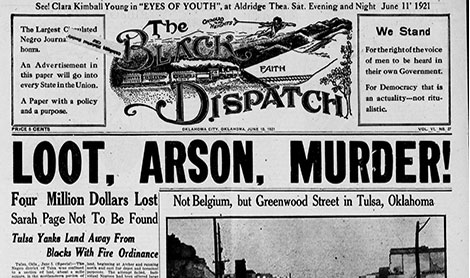
The Black Dispatch
June 3, 1921
June 10, 1921
June 17, 1921
June 24, 1921
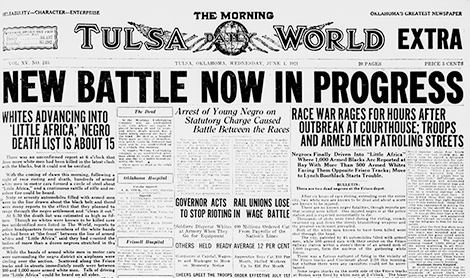
The Morning Tulsa Daily World
June 1, 1921, extra edition
June 1, 1921, second extra edition
June 1, 1921, final edition

